Asus ROG Strix GL553VE review – multimedia laptop
The Asus ROG (Republic of Gamers) series doesn’t need much introduction among those interested in gaming notebooks, as it has been an established line for many years now, yet more recently Asus have also released a dubbed-down subfamily in the ROG line, called ROG Strix.
While the ROG series includes Asus’s best offers in the niche, the ROG Strix line includes mid-level multimedia or budget gaming devices meant to perform well and not cost an arm and a leg, while sacrificing certain features you’ll only find on the higher end models.
In this article we’ll talk about the Asus ROG Strix GL553 series, and to be more precise the GL553VE model, an early-2017 15-inch notebook built on quad—core Intel Kaby Lake hardware, DDR4 memory and Nvidia GTX 1050 Ti graphics.
We’ll take you through all the nits and bits, so by the end of the post you’ll know what to expect from this computer, where it might fall short and whether it’s the right one for you or not.
Specs as reviewed
Asus ROG Strix GL553VE
Screen
15.6 inch, 1920 x 1080 px, IPS, non-touch, matte
Processor
Intel Kaby Lake Core i7-7700HQ CPU
Vide0
Intel HD 630 + Nvidia GT 1050 Ti 4GB
Memory
32 GB DDR4
Storage
128 GB SSD (M.2 NVMe) + 256 GB SSD (2.5″ SATA) + 1 TB 7200 rpm HDD (2.5″)
Connectivity
Gigabit LAN, Wireless AC , Bluetooth 4.1
Ports
2x USB 2.0, 2x USB 3.0, 1x USB Type-C(GEN 1), HDMI, mic/earphone, SD card reader, LAN, Kensington Lock
Baterry
48 Wh
Operating system
Windows 10
Size
383 mm or 15.07” (w) x 255 mm or 10.03” (d) x 30 mm or 1.18” (h)
Weight
5.31 lbs (2.41 kg)
Extras
RGB backlit keyboard, optical-drive or optional 2.5″ storage craddle, webcam
It’s important to note that we’re analyzing a pre-production version of this laptop, identical in terms of specs and features to the final retail units, yet with a slightly different lid-cover and design elements. We’ll get in depth below.
Also, keep in mind Asus offers a few different GL553 models and they’re all mostly the same, except for some hardware differences on the inside. The GL553VE comes with Kaby Lake HQ processors and Nvidia 1050 Ti 4 GB graphics, the GL553VD comes with Kaby Lake HQ processors and Nvidia GT 1050 4GB graphics, while the older GL553VW comes with Skylake HQ Processors and Nvidia 960M graphics.
Design
Our test unit gets a different lid-cover than the GL553 production models, a more tamed down version, which unfortunately won’t be available in retail, but the Asus FX553 series comes close to its design lines. It also gets less branding elements on the interior, but except for these details, the overall construction and feel between our review unit and the final products is the same.
The GL553s are mostly built out of plastic, used for the underbelly, interior and screen bezel, with a sheet of brushed aluminum on top of the screen. The main deck is fairly sturdily crafted and doesn’t show much flex in daily use, nor in the palm-rest or the keyboard-frame, but the hood is a little more flexible than I’d prefer. It also shows smudges easily, as dark metallic surfaces do. The interior shows smudges as well, but they’re not that obvious due to the brushed texture of the plastic used for this part, while the bottom gets a nice looking, futuristic pattern.
Aesthetically the hood is mostly black, with two orange stripes and a backlit ROG orange logo in the middle. There are more orange accents on the also black interior (a Strix logo, the framing around the touchpad), and even the USB ports and speaker grills are painted orange, while the radiator’s fins are red and peak through the grill on the left edge. I’m not a big fan of such color blots on a laptop, but given most other OEMs include them in their budget-gaming/multimedia options, I reckon most consumers want them.
Anyway, the GL553s are a little thinner and lighter (5.31 lbs on our scales, but 5.51 lbs according to the official specs) than their predecessors, the ROG GL552s. They’re also quite compact, which corroborated with the fairly strong build makes them easy to carry around and use everyday. There are also no sharp edges or pointed corners to bother, plus the screen can be lifted with a single hand (barely, but is possible). Two hinges keep the screen in place, and they’re quite firm and allow the display to lean back to about 145 degrees. Hopefully they’ll prove reliable, but it’s too soon to call on that. Their exterior shell is made from plastic, but the inner mechanism is metallic and attaches to the laptop’s chassis through metallic plates.
The IO is quite practically placed on this laptop as well, with most of the connectors on the left side, which leads to a less-cluttered right edge. You’ll find the DC-IN there, two USB Type A (3.0) and one USB Type C slot, LAN and a full-size HDMI port. The card-reader is placed on the front lip, with a handful of status LEDs above (fairly dim, yet still visible and a little annoying in dark rooms) and flanked by the speaker cuts, while the left edge includes another USB Type A port (2.0), the Kensignton lock and the optical drive. Yes, this laptop still includes an optical drive. That USB Type C port only support USB 3.1 gen 1 speeds, so there’s no Thunderbolt 3.
Screen
There’s a matte 15.6-inch display on this laptop with a decent FHD IPS panel. It offers average brightness, contrast and color reproduction, as well as average response times. On the other hand, it uses PWM for brightness adjustment across the range, according to this article, and the overall brightness uniformity is rather poor.
The technical aspects are mentioned below, and if you want to address the out of the box skewed gamma and colors you can use our calibrated profile available here.
- Panel HardwareID: LG Philips LP156WF6 (LP156WF6-SPB6);
- Coverage: 92% sRGB, 68% NTSC, 71% AdobeRGB;
- Measured gamma: 2.1;
- Max brightness in the middle of the screen: 293 cd/m2 on power;
- Contrast at max brightness: 640:1;
- White point: 7200 K;
- Black on max brightness: 0.46 cd/m2;
- Average DeltaE: 3.02 uncalibrated, 1.13 calibrated.

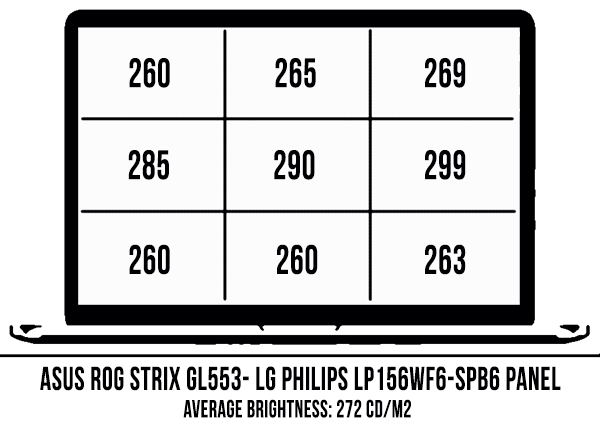
I’ll also add that this screen leans back to about 145 degrees, which might be a little limiting for lap use, but such a laptop will probably spend most of its time on a desk anyway and you’re not going to find it an inconvenience in this case.
Keyboard and trackpad
The retail versions of the GL553 get a chroma RGB backlit keyboard with four different zones that can each be lit in different colors. You can adjust the colors from the included Asus Aura application, but this malfunctioned on our test model, which only offered red illumination.
As far as I can tell, that’s the only difference from the keyboard on this sample and the final models, so my feedback on the experience with the keyboard should be useful. Take it with a small grain of salt though and look for other opinions as well, since there is a slight chance this pre-production version feels a little different than the final keyboards.
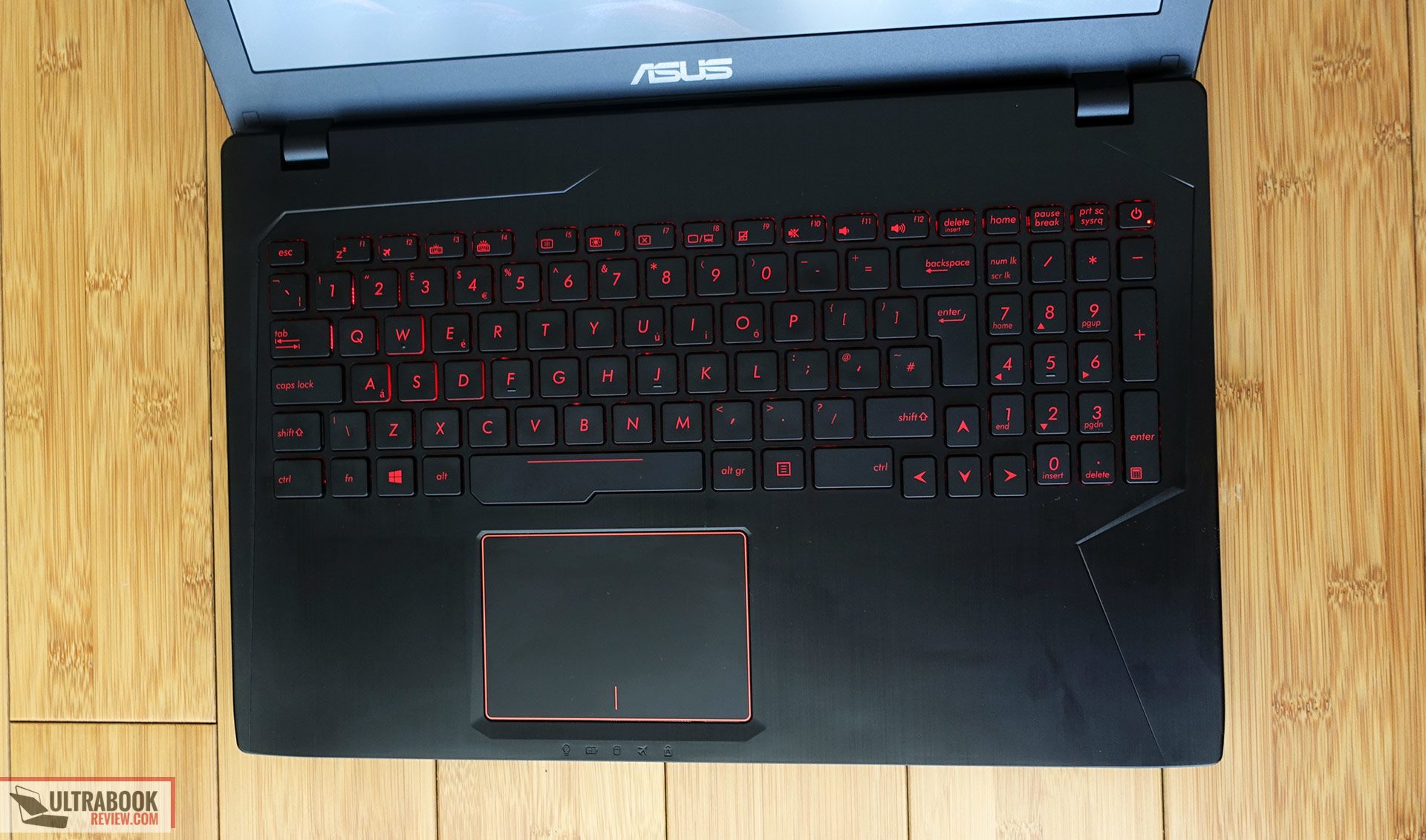
Anyway, Asus went with deep-stroke keys (2.5 mm) here and personally I’m a bigger fan of shorter travel keyboards. As a result, it took me some time to get used to the fact that I had to hit the keys harder and a little longer in order to register input properly. A few hours later, I was able to type fairly accurately, yet still about 10% slower than my average speed with my Dell XPS 13.
The layout on the other hand leaves a mixed feeling. On one hand, most keys are 15 x 15 mm and proper spaced, plus the WASD keys are highlighted and the space key is larger than usual. On the other, the NumPad section and the directional keys are narrower, so they feel quite cramped. The arrow keys are slightly lowered and spaced from the other keys, but this trick doesn’t make much difference in practice, given the extra spacing is actually very small and their physical size is reduced when compared to the other keys. The Power button is also a part of the keyboard, integrated as the top-right key.
Overall, I feel this keyboard is an improvement from the keyboards on older Asus multimedia laptops and I expect most users to get used to it quickly, especially those coming from older laptops. But there’s still room for improvement.
The trackpad is placed beneath the keyboard, slightly recessed into the palm-rest and graphically framed by an orange border. It performs fine, with no significant glitches with daily use, swipes, taps or gestures. It’s made out of plastic though, so it’s not as smooth as other options and does sound hollow when tapped a little firmer, plus the physical clicks are rather stiff, but overall it does what it’s supposed to. For accuracy, you’d still have to use a mouse though.
Hardware and performance
You’ll find the ROG GL553 in a bunch of different configurations, yet our test model is one of the highest specked versions available, with a Core i7-7700HQ processor, 32 GB of DDR4 RAM, Nvidia GTX 1050 TI graphics with 4 GB of VRAM and hybrid storage: one M.2 SSD, a 2.5″ SATA SSD and a 7200 rpm HDD. The M.2 slot supports NVMe speeds, yet from what I can tell Asus will only equip the laptop with SATA 3 SSDs, so you’ll need to upgrade that yourself. The included HDD is also a little faster than what most OEMs put on their similar notebooks, but as a 7200 rpm drive is also noisier, so you might want to replace it with a 2.5″ SSD as well.
Our test unit got one more SSD mounted with an appropriate cradle instead of the optical drive, the 256 GB MTFDDAK256TBN drive. Initially I suggested that was an M>2 drive somewhat placed in a slot behind the motherboard, thus not visible, but I was wrong.
There’s no quick access panel to the internals on the back of this laptop, but getting to the components is not a complex task either. You’ll have to unscrew a handful of Philips screws that keep the back-panel in place, and be careful there’s one hidden behind a rubber cover in the middle of the laptop. Once these are taken care of, the underbelly with quickly snap off.
Inside, the 2.5″ bay and the PCIe M.2 storage drive are easily accessible, as well as the two RAM slots, the optical drive and the Wi-Fi module. Like I mentioned earlier, the optical drive was replaced with a 2.5″ storage cradle on this test unit, that takes a SATA 2.5″ SSD. The optical drive occupies a big chunk of the interior, and as a result there was only enough space for a tubular 48 Wh battery placed towards the top, between the hinges. Personally, I would have preferred a bigger battery instead of that optical drive which I doubt many find use for anymore in this day and age. The speakers are also visible on the front lip, as well as the hinges’ mechanisms and the cooling solution.
Performance wise, this kind of laptop can handle a lot, from all sorts of basic activities like browsing, editing documents or watching movies, to more taxing chores, like Photoshop, Premiere, Eclipse and other demanding applications. There’s some bloatware installed, so it would be wise to get rid of it in order to get the most out of the hardware.
I haven’t noticed any speed loses in actual use, nor in games or benchmarks, and you can find more details in the data and pictures below.
- 3DMark 11: P8724;
- 3DMark 13: Time Spy – 2352, Fire Strike – 6373, Sky Driver – 17801;
- PCMark 08: Home Conventional – 3521;
- Geekbench 3 32-bit: Single-Core: 3807, Multi-core: 136221;
- Geekbench 4 64-bit: Single-Core: 4664, Multi-core: 14079;
- CineBench 11.5: OpenGL -, CPU 7.99 pts, CPU Single Core 1.71 pts;
- CineBench R15: OpenGL – fps, CPU 736 cb, CPU Single Core 159 cb;
- x264 HD Benchmark 4.0 32-bit: Pass 1 – 166.08 fps, Pass 2 – 40.53 fps;
- x264 HD Benchmark 5.1 64-bit: Pass 1 – 75.42 fps, Pass 2 – 16.16 fps.
When it comes to gaming, keep in mind this is the GL553VE version of the laptop, with Nvidia 1050 Ti graphics, a chip that will handle most titles at FHD resolution and high details. Expect a drop in performance if you’ll opt for the GL553VD model with Nvidia GT 1050 graphics. There’s a short comparison between these two variants, as well as the older Nvidia 900 series chip and the superior GTX 1060 chip in this article, as well as in this one.
GTX 1050 Ti FHD Ultra
GTX 1050 4GB FHD Ultra*
Shadow of Mordor
57 fps
48 fps
Grid Autosport
85 fps
–
Tomb Raider
88 fps
81 fps
Bioshock Infinite
72 fps
66 fps
Total War: Attila
21 fps
–
Need For Speed Most Wanted
60 fps
60 fps
*estimates based on what the chip is capable of, did not actually test a GL553VD model
Gaming on battery is also somewhat limited, as the GPU and CPU don’t run at full-speeds in these cases (details in one of the pictures above). As a result, Need for Speed: Most Wanted would only average 55 fps on FHD Ultra settings, but with more demanding titles the loss in performance is more significant.
One last thing to add here is that the GL553 does throttle in stress tests with Prime 95 and Furmark running simultaneously, but even in these case the CPU only gradually looses speed as the temperatures get higher. You’re not going to run into such scenarios in actual use, so there’s really no reason to worry about throttling issues on this laptop.
Emissions (noise, heat), Connectivity and speakers
There’s one single fan inside the ROG GL553, but it’s active all the time, even with the most basic of loads. I measured a noise level of around 39 dB with daily use (with my iPhone app, ambient noise being at 34 dB), which is fairly low and can be covered by speakers when watching a movie or having a song playing in the background. However, the fan’s speed tends to fluctuate and occasionally ramp up for a few seconds, then quiet down, and then ramp up again, which I find really annoying. There’s a fan-control setting in the included ROG Game Center, but is not able to lower the speeds very much, at least not on this test unit.
Under load, the fan spins faster and is nosier, going to up to 45 dB at head level. That’s a little noisier than the Acer Nitro VX15 (42 dB) and even laptops with Nvidia 1060 graphics (44-45 dB on the Acer V15 Nitros, 45 dB on the MSI GS63), so at this point you’ll need headphones to completely cover it.
As for temperatures, due to the 30 mm body and plastic build, the laptop remains cool with daily chores, but the impressive part is how cool it actually runs with demanding loads and gaming, where the interior or the back barely go past 37 degrees Celsius, while most other similar laptops get to 45s and up. The hottest point on the entire case is just underneath the space key, but even so, the GL553 is one of the coolest running machines I’ve tested in a long while. See the pictures below for more details.
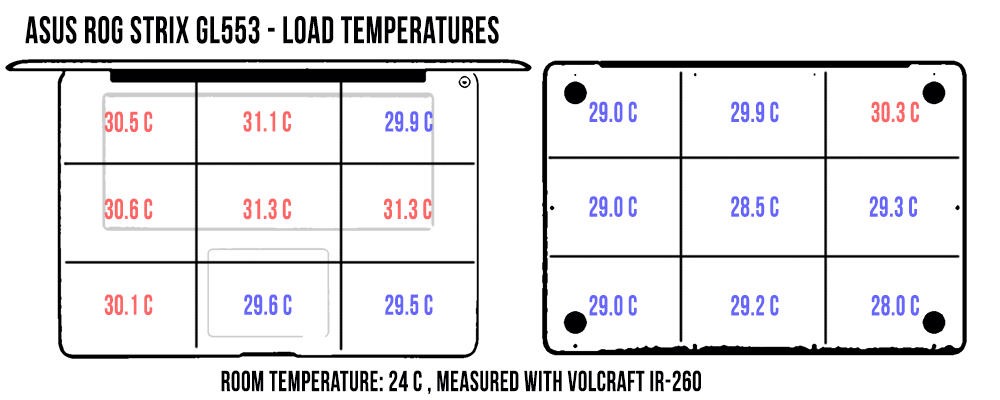
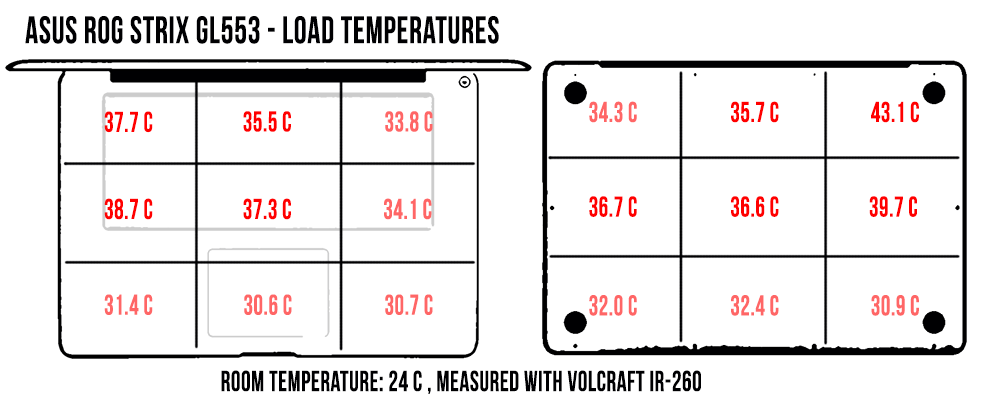
*Daily Use – 1080p Youtube clip in EDGE for 30 minutes
*Load – playing Need for Speed Most Wanted for 30 minutes
Connectivity wise there’s Gigabit LAN, Bluetooth and Wireless AC on this laptop. Asus went for a Realtek RTL8723BE wireless module on this test model, which is not a very good performer nor right near the router or at 30 feet with two walls in between. Luckily, replacing the Wi-Fi chip is a simple task and if your retail unit comes with the same Realtek module, I’d suggest doing it asap.
There are only two speakers on the GL553 and they fire through some narrow cuts on the front lip. But despite that, they sound nice as long as the Multimedia setting is picked from the included Sound Wizard app, with no distortions and quite a well balanced audio profile. They’re not very loud, averaging about 80 dB at head-level in our tests, but they’re loud enough for watching movies and listening to music in most environments. Also, I would have expected these speakers to be easily muffled when using the laptop on the lap, but covering their cuts doesn’t have a major impact on the sound quality.
As for the webcam, well, it’s quite poor, with HD resolution and crappy image quality, especially in poor light.
Battery life
There’s only a 48 Wh battery on this laptop and as a result you shouldn’t expect it to break any battery life records. See the numbers below for more details:
- 10.6 W (~4 h 30 min of use) – very light browsing and text editing in Google Drive, Balanced Mode, screen at 30%, Wi-Fi ON;
- 10.8 W (~4 h 25 min of use) – 1080p fullscreen video on Youtube in Internet Explorer, Balanced Mode, screen at 30%, Wi-Fi ON;
- 9.0 W (~5 h 20 min of use) – 1080p fullscreen .mkv video in the Movie app, Balanced Mode, screen at 30%, Wi-Fi ON;
- 10.5 W (~4 h 30 min of use) – 4K fullscreen .mkv video in the Movie app, Balanced Mode, screen at 30%, Wi-Fi ON;
- 17.5 W (~2 h 45 min of use) – heavy browsing in Edge, Balanced Mode, screen at 30%, Wi-Fi ON;
- 65.0 W (~45 min of use) – gaming, High Performance Mode, screen at 30%, Wi-Fi ON.
The GL553VW comes with a 120 Wh power brick and a full charge takes over 2 hours.
Price and availability
The Asus ROG GL553 series is already available in shops in most parts of the world.
The higher end GL553VE is listed for around $1199 in the US as of early March 2017, with a Core i7 processor, 16 GB of RAM, Nvidia GTX 1050 Ti graphics, a 256 GB SSD and 1 TB 5400 rpm HDD. A similar configuration goes for around 1400 EUR in Europe.
The GL553VD on the other hand starts at between $1000 to $1100 at the time of this post, for a configuration with the same Core i7 processor, but only 8 GB of RAM, Nvidia GTX 1050 graphics with 4 GB of VRAM and a regular 7200 rpm HDD, so you’ll want to add more RAM and an SSD to that.
Other configurations might be available as well, so make sure to follow this link for updates or models and prices at the time you’re reading this article.
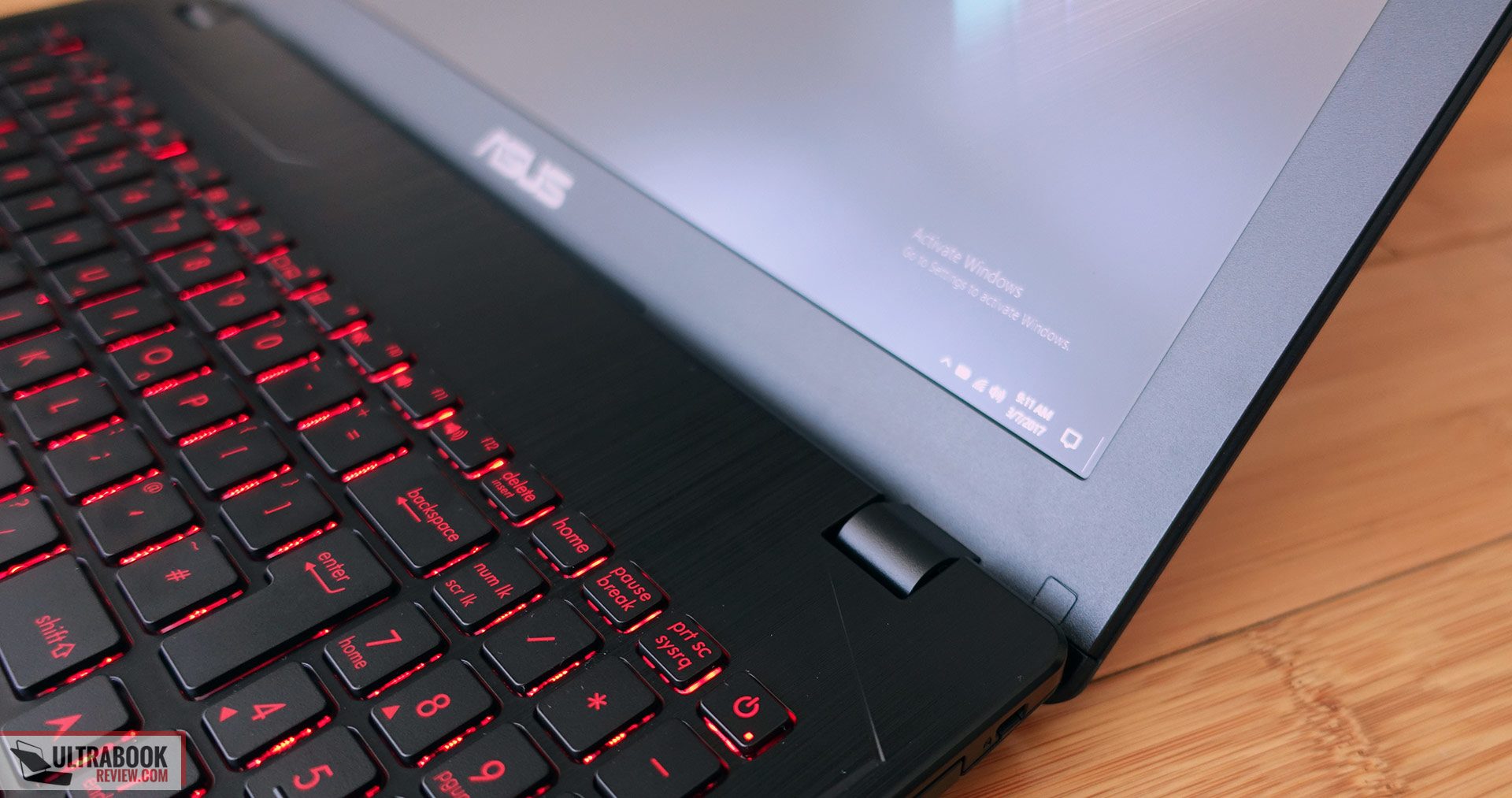
Final thoughts
Drawing the line, the Asus ROG Strix GL553 is overall a good laptop, but one that nor excels or fails in any significant way, from build to screen quality, keyboard, IO or battery life. Performance and especially the low case temperatures are indeed its strong suits, but at the same time its fan is aggressive and noisy.
Competition is however tough in this niche of multimedia laptops with Nvidia 1050 and 1050 Ti graphics, and in my opinion Asus needs to cuts down prices in order to make this series more competitive, especially for the GL533VE configuration. Acer for instance sells the Nitro VX15 for around $1000 in a configuration very similar to the one that Asus charges $1200 for. Dell has a similar offer of the Inspiron 15 7567 Gaming notebook for around $1100 (reviewed here) and there’s also MSI with the GL62M (around $1200), Eluktronics with the N850HK1 (around $1100) and even Samsung with theNP800G5M (around $1200). You know you’ve got a problem when Samsung laptops are more affordable than your own.
On top of these, the GL553VE is actually more expensive than laptops with Nvidia GTX 1060 3GB graphics, like the Asus FX502VM or the MSI GP62 Leopard Pro, and there’s no way to justify picking a 1050 Ti over a 1060 and paying extra for it.
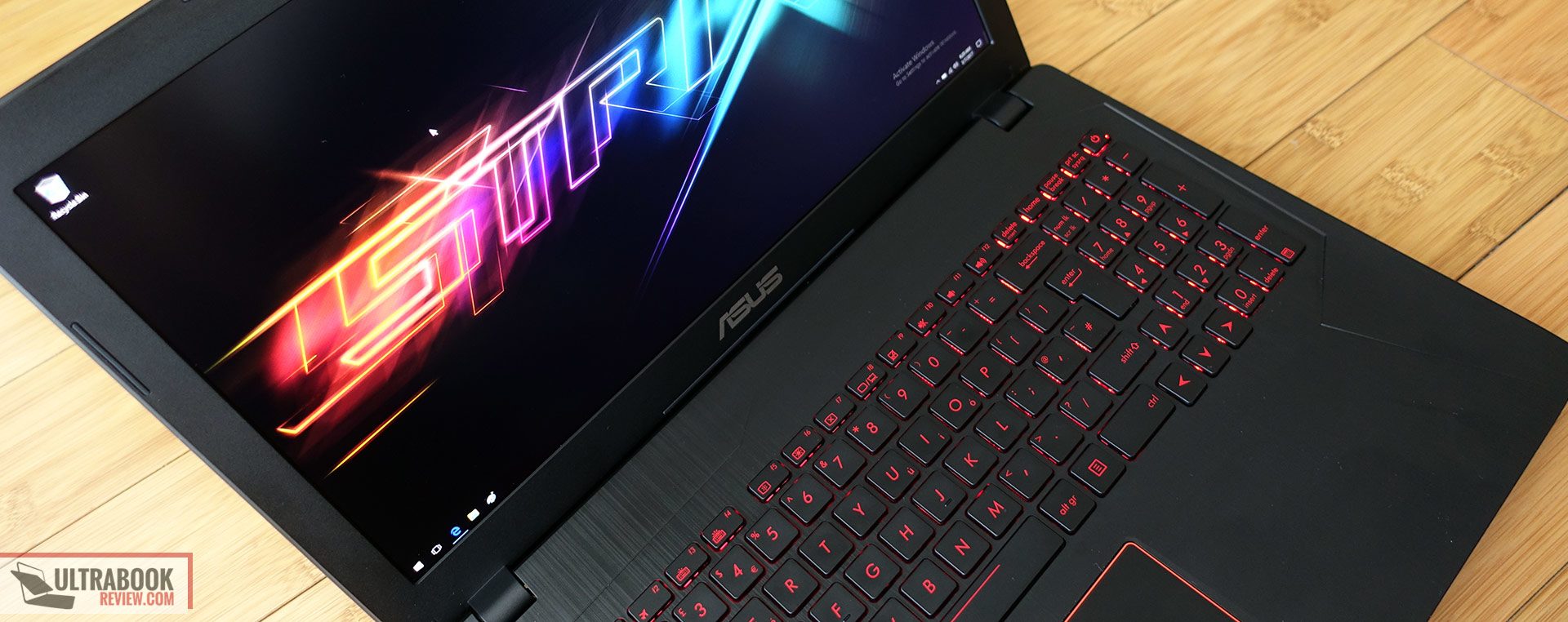
Bottom point, while the GL553s should offer most uses what they desire, being “good enough” does not justify charging potential buyers a premium. That’s why, until these come down in price, they are not at the top of my lists. You should consider them later on when they’ll get more competitive pricing (and that will happen sooner than later), but even at that point, make sure to also check out the competition and analyse the strong and weak points of each option before taking the plunge.
With that in mind we’ll wrap this up here, but please get in touch if you have anything to add about the Asus ROG Strix GL553s or have any questions about the series.
Disclaimer: Our content is reader-supported. If you buy through some of the links on our site, we may earn a commission.
Navigation: Ultrabookreview.com » 15.6 inch or larger
Our content is reader-supported. If you buy through some of the links on our site, we may earn a commission. Terms


Review by: Andrei Girbea
Andrei Girbea, Editor-in-Chief. I’ve a Bachelor’s in Computer Engineering and I’ve been covering mobile technology since the 2000s. You’ll mostly find reviews and thorough guides written by me here on the site, as well as some occasional first-impression articles.
. I’ve a Bachelor’s in Computer Engineering and I’ve been covering mobile technology since the 2000s. You’ll mostly find reviews and thorough guides written by me here on the site, as well as some occasional first-impression articles.






